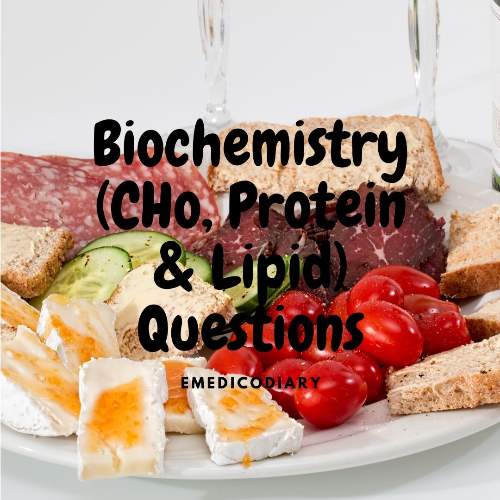Biomolecules: Carbohydrates, Protein, Lipid, Enzyme
Carbohydrates
Short questions
- Define carbohydrates?
- Why sucrose is not reducing sugar.
- Name non reducing sugar?
- Name the isomers of monosaccharides. Define isomers?
- Name three references carbohydrates and reference carbon.
- Name disaccharide with the source.
- What is sugar? State the importance of glucose and ribose.
- Mention important biomolecules in our bodies.
- Describe mutarotation.
Broad questions
- Classify carbohydrate
- Define and classify polysaccharide
- Define and classify monosaccharides' source of the biological importance of monosaccharides.
- Give the properties of CHO?
- Give the properties of glucose?
- Draw different types of structure of glucose?
- Describe the isomerism of glucose?
- Give the Biomedical importance of CHO.
- The difference between aldose and ketose.
- The difference between D glucose and l glucose?
- The difference between Isomer and epimer
- Give the structure of D glucose and D Galactose?
- Define isomerism
- Give the importance of mucopolysaccharide
- SN: Mutation, Glycogen, invert sugar?
- Give the name of mucopolysaccharide?
- What do you mean by polypeptide and protein
- Biomedical importance of glucose?
Protein
Broad questions
- Define and give the functional classification of protein
- Give the biological importance of protein.
- What is the structure of a protein?
- State the importance of primary structure.
- Define and classify amino acid
- What is nucleic acid? The difference between DNA and RNA
- Give the structure and function of DNA
- What do you mean by domain?
- Name the nitrogenous base? Mention the importance of nucleotide
- What are nucleotides and nucleosides?
- Structure: purine and pyrimidine ring
- How protein is organized into different structures
- What are the properties of amino acid
- Short note: i) essential amino acid ii) peptide linkage iii) zwitterion iv) denaturation v) what do you mean by the amino acid pool?
- Biomedical importance of amino acid
- Draw structure of amino acid glucose cholesterol
- Name the biologically important peptide with their function
- How hemoglobin synthesis
Lipid
- Define lipid and classify lipid
- What are derived lipids?
- Give the properties and importance of lipid
- Mention general structure of FA feature
- Classify fatty acids what do you mean by omega3 fatty acids
- What are the lipoprotein present in fasting palm
- Why form’s fatty acids are called bad fatty acids
- Define and name the EFA with clinical nature, source, and importance
- Mention the biological importance of fatty acids
- State the importance of PUFA
- Define and classify lipoprotein. Give their normal blood levels. How they are separated
- What is the function if prostaglandin? How they are synthesized?
- Importance of lipoprotein
- Name the essential fatty acids
- Define and classify phospholipid with biomedical importance
- Mention biomedical importance of eicosanoids
- State the source, chemistry and importance of cholesterol.
- Name the plasma lipids with their reference values
- Short note: i) prostaglandin ii) dietary lipids.
- How can you stop cholesterol
- Features of fatty acids
- What is ceramide
Enzyme
- Define and give IUBMB classification of an enzyme?
- Name 5 chemically imp. Enzyme with their blood values and with clinical imp.
- Factors affecting enzyme activities.
- How the enzyme act?
- Describe enzyme inhibitors with action.
- Define isoenzyme and coenzyme
- The difference between enzyme and coenzyme?
- What is Km value? Importance of CK of and ALT.
- Name the Vit B complex to derive co enzyme s.
- How an enzyme-catalyzed reaction? Explain the role of PH on enzyme action.
- Define co-factors.
- Give two examples of isoenzyme with their importance.
- Short note: Enzyme inhibition.
Also read: Biochemistry Questions & Answers
Also read: Question Collection

Comments (0)